The concept of grounding in safety regulations
Earthing (often called Grounding in the United States) is an important topic in the field of electricity, especially in Safety.
First, let's understand why grounding is required from a safety perspective:
( I ) Equipotential - Assuming that there are two instrument housings, each with a different potential, there is a clear risk of electric shock when someone inadvertently touches both instruments at the same time. Therefore, if all instruments can be properly grounded, the risk of potential difference can be greatly reduced. This situation is especially important in hospitals, because patients often use several electronic therapy instruments at the same time, plus metal bed frames, bedside lamps, etc., which are more likely to cause conductive accidents due to potential differences.
(II) Exception Protection - When the insulation of the utility transformer breaks down due to abnormal conditions, grounding measures can short-circuit the high voltage on the primary side to Ground or Earth, reducing the occurrence of danger. The so-called Class I products also use the same principle to achieve the function of protection. Similarly, in the event of a short circuit between the circuit and the housing of the product, the grounding of the housing can also provide Bypass protection.
( iii) Voltage Stabilize - Because the earth can be considered a very stable potential, grounding can also provide a very smooth reference point.
( IV ) Over current Protective Device action - When an abnormal condition occurs, the large current caused by the connection to the earth can urge the overcurrent protection element such as a fuse to act early, and achieve the function of protection.
( V ) By-pass the Leakage Current - Electrical products will have leakage current, but the size is different, the main cause of leakage current is the presence of stray capacitance, and improper technology to deal with electromagnetic interference. With grounding in place, these leakage currents can be carried away.
However, with all the benefits, grounding also adds a number of problems:
( I ) Receptacle problem - In the United States, houses built after 1962 have sockets for grounding, in other words, there are many houses with sockets that do not have grounding holes, and in Taiwan, this is also a very common situation. In this case, it is difficult for the product to use grounding to achieve a certain degree of protection. There are many people who use the Three Pins To Two Pins Adapter to solve the problem of socket non-conformity, and worse, some irresponsible decorators will install three-hole sockets on a power supply that is not grounded at all, causing misunderstanding.
( II ) The Winning Problem - In power distribution systems, different colors represent different wires. In the United States, for example, black represents Line or Ungrounded Conductor, and white represents Neutral or Grounded Conductor. In Europe, brown is usually used to represent the line of fire, blue for the middle line, and green or green to yellow for the ground line. However, most electrical appliance users do not know the meaning of these colors, and once the ground wire is connected incorrectly, the danger of the product will appear. In addition, the use of ungrounded Extension Cord is also very common.
( iii) Poor grounding is prone to occur - although grounding can provide a lot of protection, if the impedance of the ground is too high, these effects will be greatly reduced. The use of ground wires that are too small in diameter or too long in length is the most common list of poor grounding.
( IV ) Formation of Loop - Because the product is grounded, the earth has the opportunity to become one of the paths of current, and Figure 1 is a schematic diagram of this. As a result, grounded products are dangerous; Of course, ungrounded products may also form loops due to stray capacitance, as shown in Figure 2, but their current is relatively small.
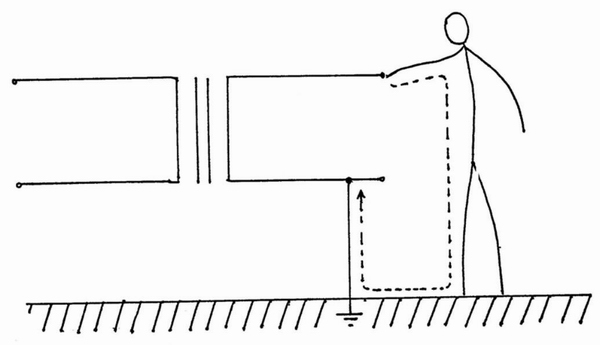
Figure 1

Figure 2
( V ) Formation of interference - because many systems have grounding, it causes the complexity of the earth current, sometimes it also forms noise-style interference, and in severe cases, the voltage rises due to the passage of large currents, resulting in mutual ripples between systems. In addition, the impedance of the earth (soil) changes with temperature, so the resistance value varies from season to season, and the rate of change is shown in Figure 3.
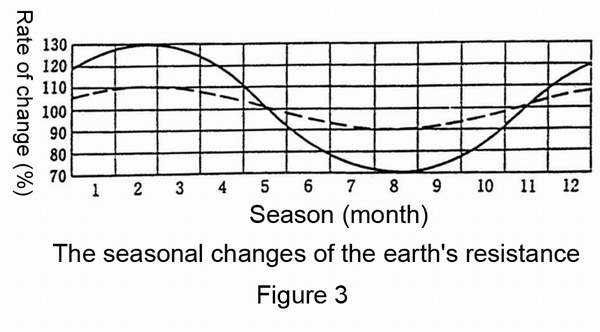
( VI ) Step Potential - When there is a lightning strike or a large current flowing to the earth, the potential near the ground post will rise suddenly, and if someone happens to be standing around the ground post, the voltage level between their feet is the so-called step voltage. Once the voltage between steps is greater than the human body can withstand, the safety of life is threatened. According to the IEEE definition, the interstep voltage is the voltage difference between any point on the ground surface near the ground post that is 1 meter apart.
If we compare it with so-called Class II products (i.e. products that are double-insulated without grounding), it will be easier to understand the advantages and disadvantages of grounding, see Table 1.
Characteristic
|
Class I Products (Grounding)
|
Class II Products (Not Grounded)
|
If the voltage of the circuit is abnormal
The rising situation, whether it can be suppressed
System?
|
Yes
|
No
|
Equipotentialization
|
Yes
|
No
|
Voltage stabilizing effect
|
Yes
|
No
|
The current is flowed
|
Yes
|
No
|
When the insulation collapses, whether there is a connection
Ground protection?
|
Yes
|
No (And because it is difficult to maintain insulation, it is only suitable for smaller systems.)
|
Is it easy to cause interference?
|
Yes
|
No
|
Security is subject to the connection of the power distribution system
Does the ground condition affect?
|
Yes
|
No
|
When in contact with the circuit, is it easy for the human body to form a path that conducts electricity to the earth?
|
Yes
|
No
|
Table 1
Therefore, a product should be designed according to Class I or Class II, in fact, there are no certain guidelines, depending on whether the product has a line that is easy to be touched, whether the place of operation is often changed, whether it is used outdoors, how the leakage is, and whether the extension cord will be often used.
In fact, if a grounded product is added with some auxiliary components, the safety of the product is more guaranteed, Ground-Fault Circuit Interrupter, or GFCI, is one of them.
The operation principle of the circuit breaker is very simple, mainly relying on a so-called Zero-phase Current Transformer, or ZCT for short, to achieve this function, as shown in Figure 4. From Figure 4, it can be seen that when the product is under normal conditions, I G will be equal to I N under ideal conditions, so two magnetic fields of the same magnitude but opposite directions are generated in ZCT, which means that the magnetic fields have canceled each other out. Once the insulation of the product fails, and someone happens to touch the product, I G will have a shunt flow through the human body, causing I G is no longer equal to I N, and the Secondary Winding of ZCT is inducted, and the circuit breaking action is automatically performed.
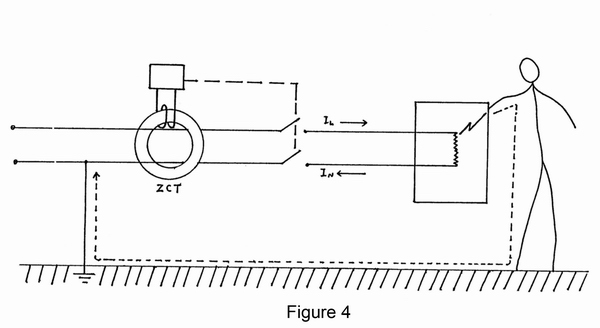
Circuit breakers are usually divided into Class A and Class B, Class A is a circuit breaker that occurs when the leakage current is greater than 5mA (equivalent to Inability to let-go), and Class B acts at 20mA (close to ventricular micro-current, Ventricular Fibrillation).
Circuit breakers can be installed in the product or installed in the power distribution system. The National Electrical Code of the United States, or NEC for short, also stipulated last year that the bathrooms, garages and outdoor sockets of new houses in the United States must be equipped with circuit breakers. In addition, UL859 in 1982 stipulated that Hair Dryer must meet a special test, that is, the test of dropping a hair dryer into water without causing electric shock, in other words, it is not feasible without a circuit breaker.
The function of circuit breakers is not only used in grounded products, but also effective for Class II products if properly designed. Although circuit breakers have the disadvantage of being susceptible to noise interference, statistics from the United States and Japan clearly prove that circuit breakers are of great help in reducing the risk of electric shock casualties.
Next, we introduce the classification of grounding:
( I ) System Grounding - that is, the grounding of the general power distribution system, which is usually connected by the intermediate point of the secondary side of the Utility Transformer, as shown in Figure 5. Although the power distribution system of each country is different, it can be mainly divided into TN-S, TN-C-S, TN-C, TT, and IT, as shown in Figure 6 to Figure 10, please refer to it. The symbols of the above different systems are derived from French, and the IT system is the main power distribution system used in France.

( II ) Ground Provision - refers to the grounding of the product enclosure (Frame or Chassis) to provide a path for flow in the event of an insulation system failure, as shown in Figure 5.

( III ) Grounding to prevent lightning strikes - that is, the grounding of lightning rods.
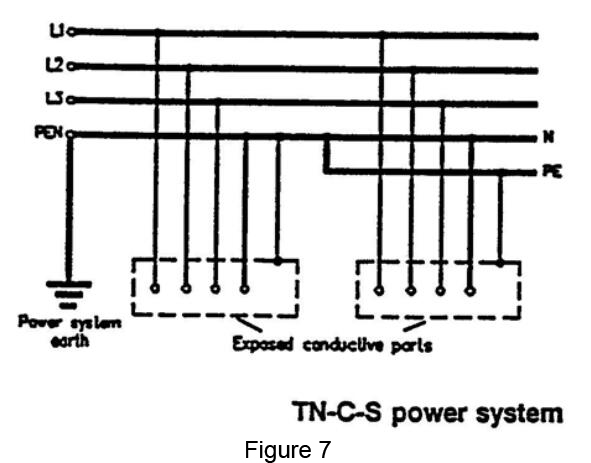
( IV ) Functional grounding - Grounding that is not designed for safety purposes, such as grounding to prevent static electricity or noise interference, and grounding to obtain potential reference points, etc., are functional grounds.


 In addition to the above discussion, general safety standards still have many requirements for grounding, and here are a few to list:
1. The grounding wire cannot be connected in series with devices such as fuses or switches.
2. The grounding wire does not have to have an insulating layer, but if it is used, it must be colored with green or yellow-green. Some standards also allow the use of transparent sleeves, as green sleeves are less easy to find.
3. If the shape of the plug or socket of the product is three Pins, the ground terminal must be longer than the other two terminals because it is necessary to ensure that the ground terminal can be contacted first when plugged in, and the ground terminal can be separated last when the power supply is unplugged.
4. The grounding must be designed so that repairs are not required to be separated unless the hazardous voltage section can be separated first.
In addition to the above discussion, general safety standards still have many requirements for grounding, and here are a few to list:
1. The grounding wire cannot be connected in series with devices such as fuses or switches.
2. The grounding wire does not have to have an insulating layer, but if it is used, it must be colored with green or yellow-green. Some standards also allow the use of transparent sleeves, as green sleeves are less easy to find.
3. If the shape of the plug or socket of the product is three Pins, the ground terminal must be longer than the other two terminals because it is necessary to ensure that the ground terminal can be contacted first when plugged in, and the ground terminal can be separated last when the power supply is unplugged.
4. The grounding must be designed so that repairs are not required to be separated unless the hazardous voltage section can be separated first.
5. If the grounding uses a post or screw for bonding, the relationship between the diameter of the post or screw and the rated current of the product must meet the requirements of Table 2.
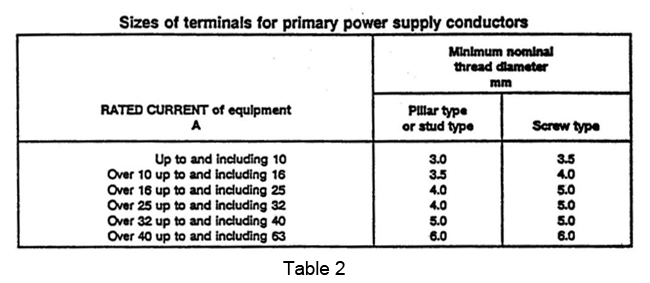
6. When grounding, avoid using two inappropriate metals for bonding, because different metals, some will produce electrochemical action with each other, one will cause a potential difference between the metals, and the other will accelerate the corrosion or deterioration of the metal. As for which metals cannot be connected to each other, please refer to Table 3 Basically, an electrochemical potential difference greater than 0.6mA should be considered inappropriate.

7. Class I products cannot use the ground wire of the Telecommunication Network as the only ground duct unless configured by a professional.
8. The same post can be shared by many ground wires, but the ground wire connected to the Branch Circuit must be below, as shown in Figure 11. In addition, general standards require the grounding of the post or screw, and accessories such as Lock Washer or Star Washer must be used to prevent poor contact caused by loosening or metal fatigue.

9. The last item, which is actually the most important, is that the impedance to ground must not be greater than 0.1Ω. The test is usually done by passing a voltage below 25A, 12V or 6V and then measuring the voltage drop to the ground diameter. The reason for using 25A is because the overcurrent protection device of the power distribution system of the general home will not exceed 20A.












